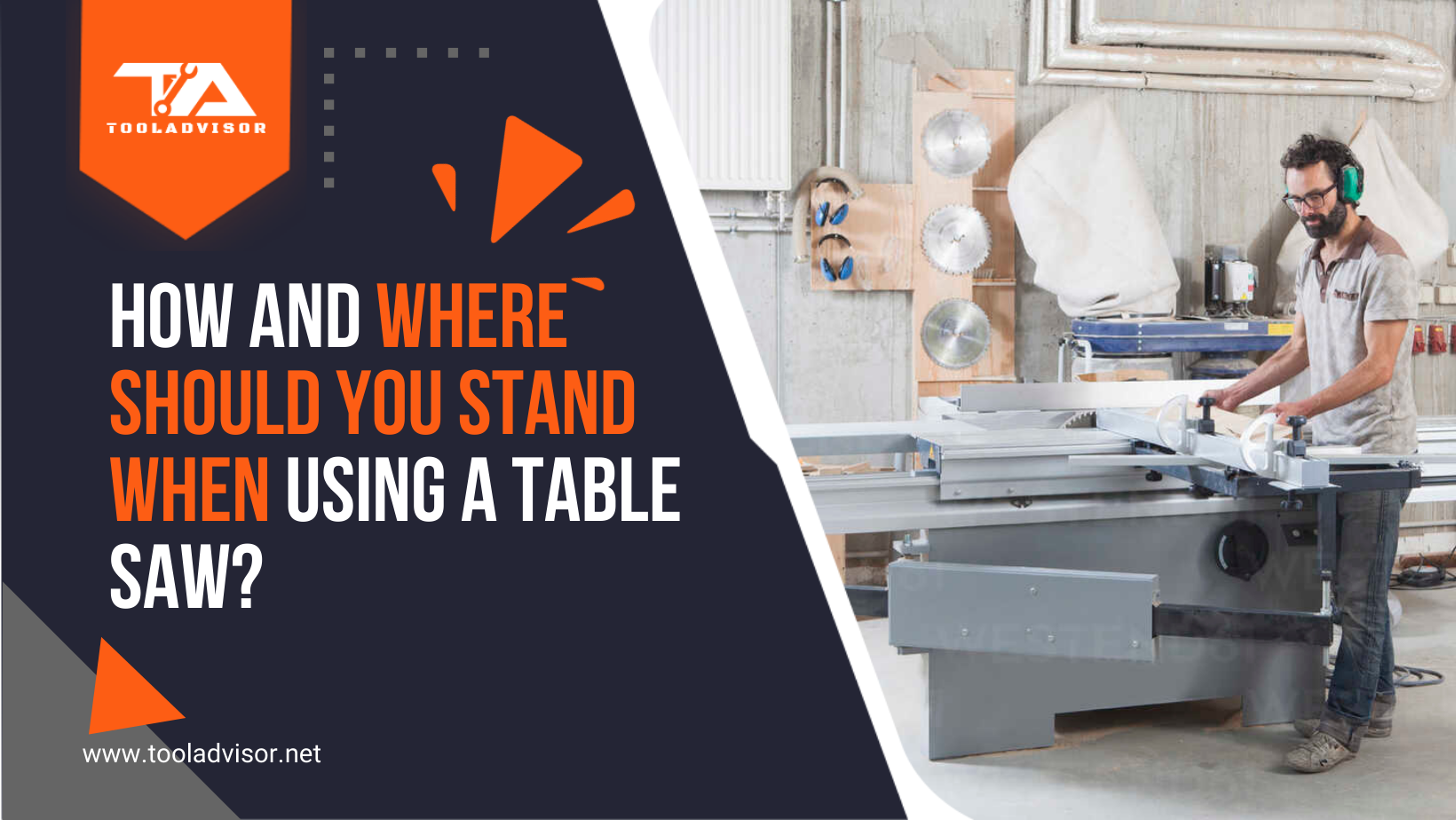Table saws are must-haves in every woodworking shop. However, novices or beginners in woodworking may wonder how a table saw works. The basic thing is that a table saw houses an electric motor that powers its circular blade to rip through the timber or any hardwood.
However, with the latest models of table saws, woodworkers can expand the cut by adjusting the blade’s position as required. The saw will make a deeper incision if you set the position higher. On the contrary, you will achieve shallow cuts if the blade’s position is lower.
Overall, a table saw is handy for all woodworking purposes, from crosscutting to ripping. Now the fact is:
If you do not use a table saw properly, it can hurt you badly. An alarming percentage of accidents reported every year from most workshops are due to the table saws. And a majority of them are caused because of the utter negligence and unawareness of the workers. So some of the common questions of woodworkers include
How to stand when using a table saw? Where to stand when using it? What’s the safest spot to stand to use the table saw? And more.
So let’s find out the safety rules and tips to follow while using table saws so that you can avoid accidents.
Where to Stand When Using Your Table Saw?
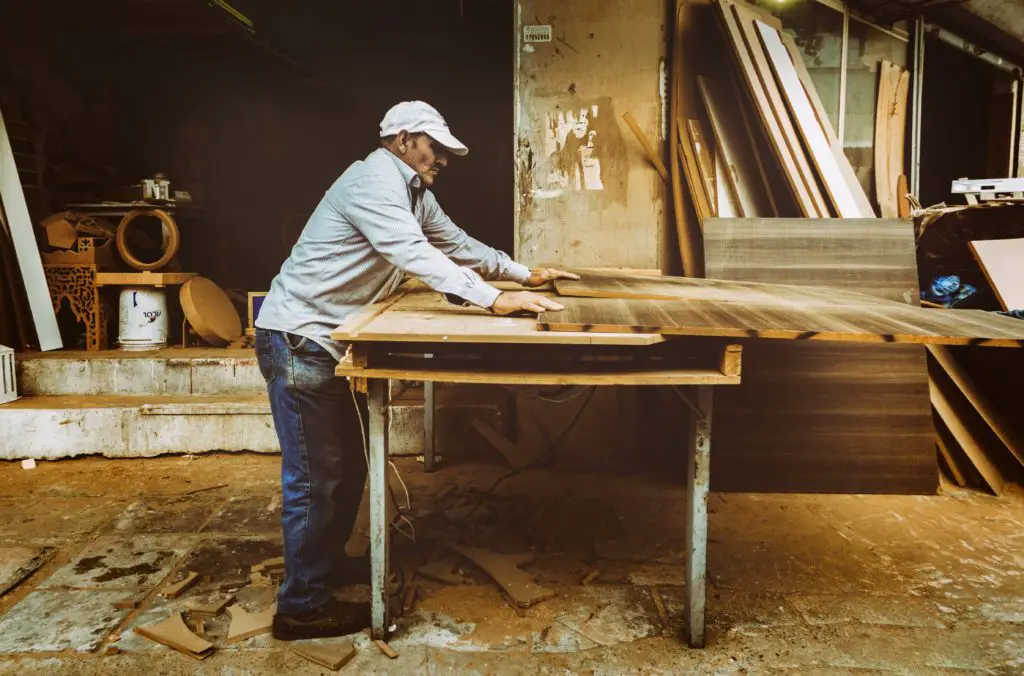
You should always choose a place where you feel comfortable. And the comfortable space is on the blade’s left-hand side, referred to as a ‘natural spot.’
At this place, you can maintain an ideal position of the blade between the saw’s fence and yourself. The fact is that standing in a natural spot will reduce the risks. It will protect you, no matter what material you are ripping. So the most protected place to stand when using a table saw is the left-hand side of the blade.
How to Stand When Using the Table Saw?
When standing in the comfortable ‘natural’ spot to use the saw, you must put the material from the left. However, right-handed people may struggle to feed the wood from the left side. No worries! Here’s a solution for right-handed individuals
- Don’t feed the wood using your left hand.
- Instead, feed it anywhere you feel comfortable except the left side.
Pro Tips to Use Your Table Saw Safely While Standing
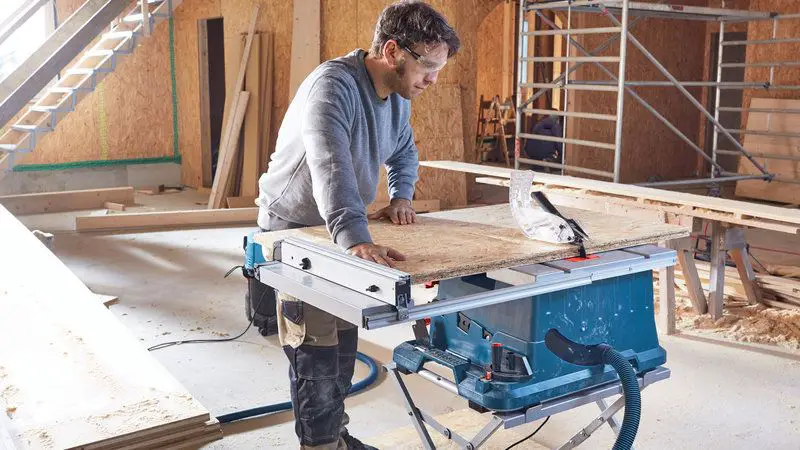
You need to make sure that you aren’t uncomfortable with your standing position. The more you can work with ease and stability, the more you can avoid injuries. Here are some pro tips for you to use your table saw safely while standing.
1. Prevent Kickback
While cutting a block of wood in the table saw, some materials or debris fly toward you. So any material reverting to the user of the device is called kickback.
Powerful saws are known to cause more kickbacks. Reversely, kickbacks are less with less powerful saws, and thus, they are more comfortable to use. Thus, it is recommended to maintain distance when using saws with powerful motors or hybrid table saws as they cause stronger kickbacks.
Nonetheless, kickbacks are dangerous, whether you are using a highly powerful saw or a comparatively less powerful one.
Table saws generate excellent horsepower that provides the power to hurl wood in any direction. Like this, you can actually get the best cut. However, a kickback can hit you whether you stand on the right side or left.
Unfortunately, it isn’t possible to predict the direction where a kickback will hit you.
2. Control Your Material Every Time
You have to take prevention from kickback, no matter where you stand when using your table saw. It is advised not to lose control over your material from the beginning till the end.
Beginners should avoid using metal components as they have more risk. Above all, you should install every safety equipment on your table saw. Get a high-quality push stick to keep a distance.
3. Spot the Emergency Turn Off Button
Table saws from top manufacturers have an emergency shut-down button, usually big.
You might be standing a bit far from the socket. Or it might not be able to pull out the plug to shut down the machine instantly. In that case, you can press the emergency button and turn the saw off.
4. Protect Your Eyes and Ears
Safety gears are imperative when using any equipment with a rotatable component, especially eye protection. Otherwise, these devices can cause projectile-related accidents. In addition, a tiny splinter can cause irreparable damage to your eyes.
Simultaneously, table saws emitting loud noise can harm the ears. Unfortunately, you may realize any damage made to your eardrums too late, as often is the case. So it is better to wear both safety glasses and earplugs every time you operate the table saw for ripping woods.
5. Don’t Wear Gloves
Unlike many other workshops and industrial-related works, wearing gloves is strictly a no when using table saws. Safe operations of table saws depend largely on the woodworkers’ tactile sensibilities.
You need excellent grip and hold while operating table saws. If you wear gloves when using a table saw, they can get caught in the rotatable blade and cause a dangerous accident.
6. Use the Right Blade
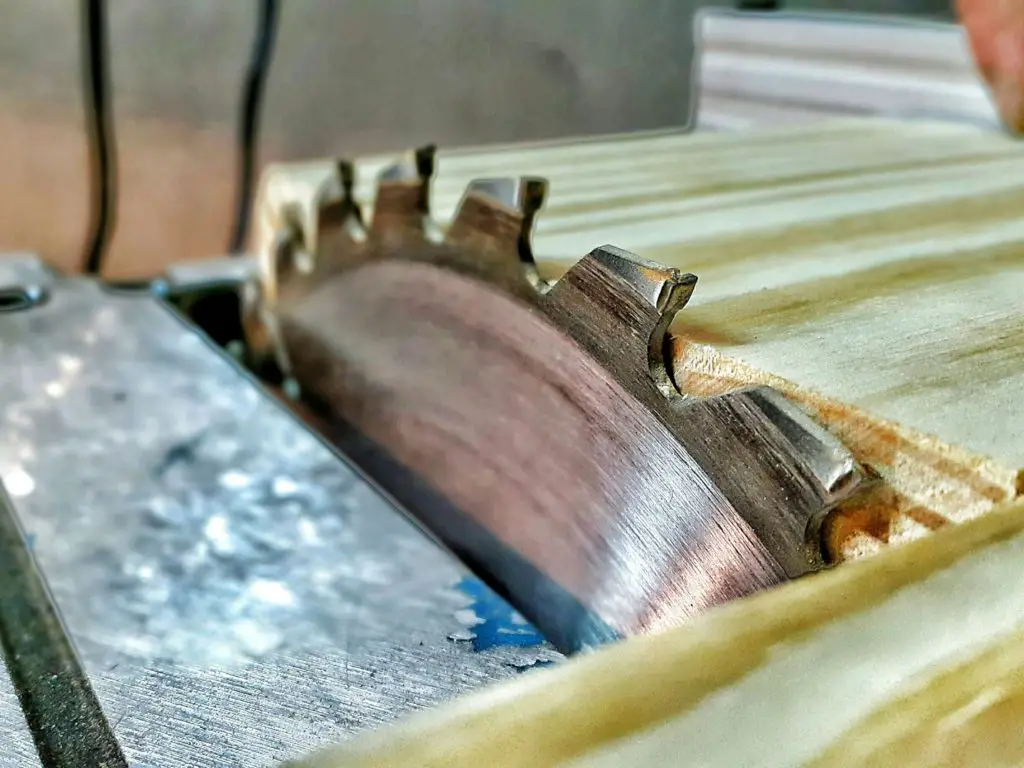
Woodworkers often face accidents when they decide to switchblades just to change from ripping to crosscut. In most cases, the blade breaks and causes projectile accidents.
It’s good to keep the saw blade sharp. Then, you won’t have to put in added effort to change the blade for the same task.
7. Set the Right Blade Height
You have to alter the blade height on top of the table saw according to the blade type used. For instance, you should set it at least a quarter inches above the wood if it is flat, with ground blades.
On the contrary, in the case of planer blades, you have to keep it high as much as possible above the table. This is because it will prevent the occurrence of any binding.
8. Use Splitters and Blade Guards
The best table saws come with blade guards, ensuring the safety of the users. However, splitters are set straight behind the blades of a table saw. As a result, they don’t allow the stock to close in on the saw’s blade, preventing binding.
9. Use Feather Boards
A feather board helps grasp the material tightly against the saw’s fence and surface. It minimizes the kickbacks’ chances simultaneously.
10. Rip Carefully
When a twisted piece of stock gets caught in the saw blade, it flings back at the user, causing kickbacks. However, it rarely happens. Furthermore, kickbacks are also caused when the blade is blunt, or the blade height is improper above the table.
Another overlooked reason resulting in kickbacks is employing poor-quality wood. However, woodworkers should place the fingers of the working hand on the fence. It will reduce the risk of the wood-feeding hand getting stuck in the device’s blade.
11. Use Push Sticks
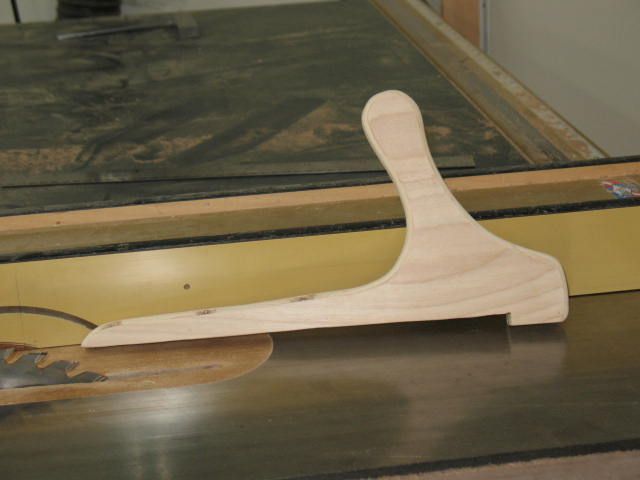
Push sticks help maintain a distance between the circular table saw hand and your wood-feeding hand. Eventually, you can protect your hand from accidentally getting caught in the rotatable blade of the saw.
Other Safety Rules to Follow When Using a Table Saw
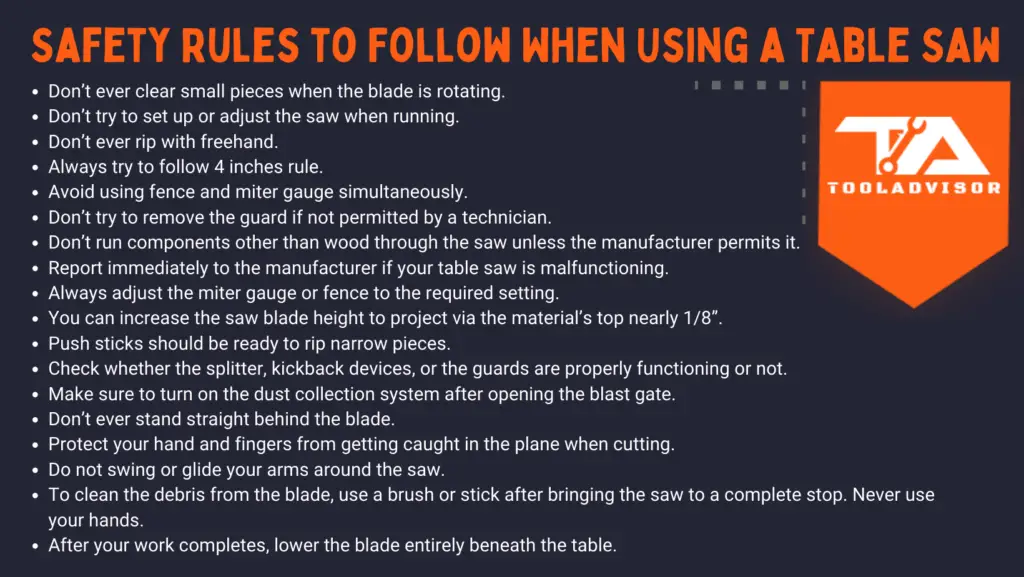
- Don’t ever clear small pieces when the blade is rotating.
- Don’t try to set up or adjust the saw when running.
- Don’t ever rip with freehand.
- Always try to follow 4 inches rule.
- Avoid using fence and miter gauge simultaneously.
- Don’t try to remove the guard if not permitted by a technician.
- Don’t run components other than wood through the saw unless the manufacturer permits it.
- Report immediately to the manufacturer if your table saw is malfunctioning.
- Always adjust the miter gauge or fence to the required setting.
- You can increase the saw blade height to project via the material’s top nearly 1/8”.
- Push sticks should be ready to rip narrow pieces.
- Check whether the splitter, kickback devices, or the guards are properly functioning or not.
- Make sure to turn on the dust collection system after opening the blast gate.
- Don’t ever stand straight behind the blade.
- Protect your hand and fingers from getting caught in the plane when cutting.
- Do not swing or glide your arms around the saw.
- To clean the debris from the blade, use a brush or stick after bringing the saw to a complete stop. Never use your hands.
- After your work completes, lower the blade entirely beneath the table.
Also Read: DEWALT DW7451 Compact Table Saw Stand: Expert’s Advice & Review
Conclusion
All in all, you have now acknowledged how and where to stand when using a table saw. However, always make sure to maintain your distance from kickback accidents, no matter which side is your ‘natural’ spot. Stand where you stay comfortable.
Moreover, never lose control of the material. Always remember to follow all the safety tips and rules mentioned above. Safety gears like eye and ear guards are must-haves for woodworkers – never forget to wear them. And use high-quality push sticks.
We hope this article will also be valuable for beginners or novices new to woodworking tactics and skills.
